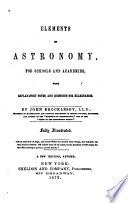 That the planets all move in elliptic orbits, of which the sun occupies one of the foci. 3. That the squares of the times of the revolutions of the planets are as the cubes of their mean distances from the sun. That the planets all move in elliptic orbits, of which the sun occupies one of the foci. 3. That the squares of the times of the revolutions of the planets are as the cubes of their mean distances from the sun.  A Complete System of Astronomy - Page 97by Samuel Vince - 1814Full view A Complete System of Astronomy - Page 97by Samuel Vince - 1814Full view - About this book
 | John Brocklesby - 1872 - 374 pages
...KEPLER'S LAW OF DISTANCES. From the third law of Kepler; viz., that the squares of the periodic times of the planets are as the cubes of their mean distances from the sun, the unknown mean distance of a planet can be found, when its periodic time is ascertained together... | |
 | William Thomas Brande, George William Cox - 1875 - 968 pages
...describes about the sun equal areas in equal times. 3. That the squares of the times of the revolutions of the planets are as the cubes of their mean distances from the sun. These three laws or general facts were discovered by Kepler from a comparison of astronomical observations;... | |
 | John J. Prince - 1877 - 184 pages
...of which the sun occupies one of the foci. (3) That the squares of the times of the revolutions of the planets are as the cubes of their mean distances from the sun." From the first of these Newton concluded " That the force acting on the planets is directed towards... | |
 | Neil Arnott - 1877 - 916 pages
...between the two things — mean distance and periodic times. The squares of the periodic times of two planets are as the cubes of their mean distances from the sun. The periodic times, or periods of revolution, of the Earth and Mars are respectively 365} days and... | |
 | Samuel Maunder - 1880 - 904 pages
...describes about the sun areas proportional to the times, 3. The squares of the times of the revolutions of the planets are as the cubes of their mean distances from the sun. KBlt'MKS (a little worm : Arab.), species of tho genus Coccus of entomologists, found In the excrescences... | |
 | James Martineau - 1885 - 516 pages
...which Newton 1 demonstrates the third law of Kepler, — ' that the squares of the periodic times of planets are as the cubes of their mean distances from the sun.' These numerical relations, therefore, would equally exist, ' whether the sun threw off the planets... | |
 | Ebenezer Cobham Brewer - 1891 - 1016 pages
...planet) will sweep over equal areas in equal portions of time. 3. The square of the periodic times of the planets are as the cubes of their mean distances from the sun. The second law Is ' the radius vector awoops over equal areas In equal limes. ' Keri-Chetib [Eeri what... | |
 | Elias Loomis - 1897 - 264 pages
...ellipse, of which the sun occupies one of the foci. (3.) The squares of the times of revolution of the planets are as the cubes of their mean distances from the sun, or of the semi-major axes of their orbits, From these facts, discovered by an examination of observations,... | |
 | Charles Annandale, Ainsworth Rand Spofford - 1901 - 532 pages
...planet, moves over equal spaces in equal times. 3. That the squares of the times of the revolutions of the planets are as the cubes of their mean distances from the sun. Galileo, who died in 1642, advanced the science by his observation* and -ASUNCION. by the new revelations... | |
 | Thomas Banks Strong - 1906 - 270 pages
...radii, ie the distances (Principia, Book I, Prop. 4, Cor. 6). The squares of the periodic times of the planets are as the cubes of their mean distances from the sun l (Ibid., Book III, Phen. 4 : Kepler's Third Law). Therefore, the centripetal forces of the planets... | |
| |